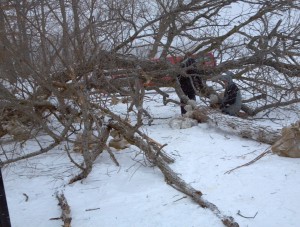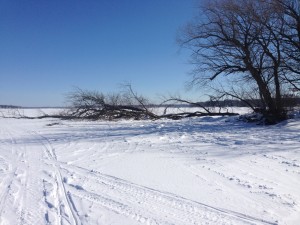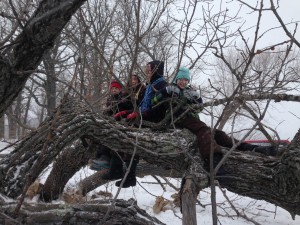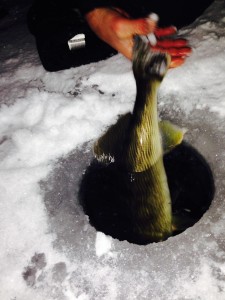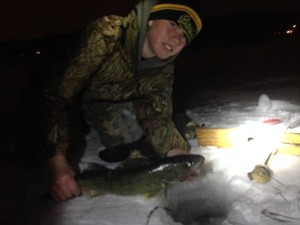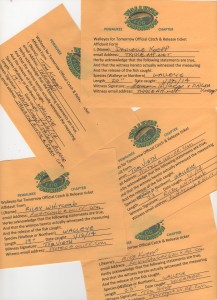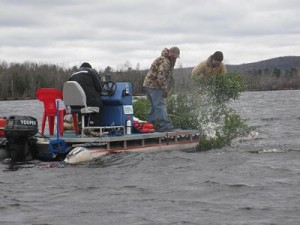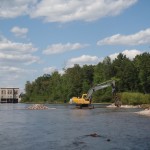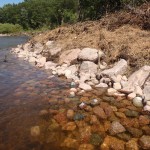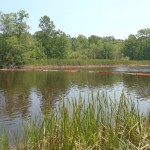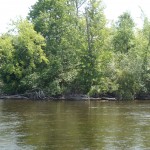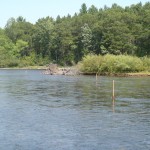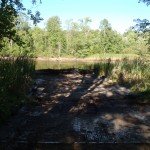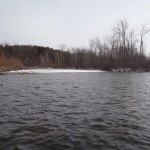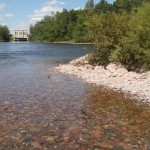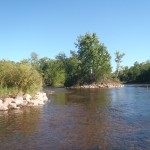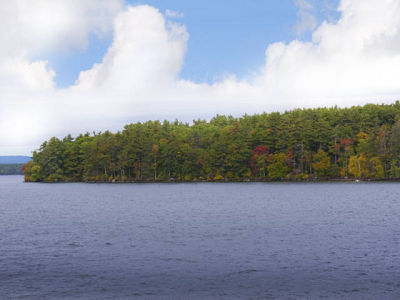Lakeshore Woody Habitat in Review
by Max Wolter
WDNR Fisheries Biologist
Sawyer County
Introduction
Coarse woody habitat (CWH) in lakes is classified as trees, limbs, branches, roots, and wood fragments at least 4 inches in diameter that enter a lake by natural (beaver activity, toppling from ice, wind, or wave scouring) or human means (logging, intentional habitat improvement, flooding following dam construction, Guyette and Cole 1992, Christensen et al. 1996; Engel and Pederson 1998). CWH serves many functions within a lake ecosystem including erosion control, as a carbon source, and as a surface for algal growth which is an important food base for aquatic macroinvertebrates (Engel and Pederson 1998; Sass 2009). Presence of CWH has also been shown to prevent suspension of sediments, thereby improving water clarity (Sass 2009). CWH serves as important refuge, foraging, and spawning habitat for fish (Hanchin et al 2003, Lawson et al. 2011), aquatic invertebrates, turtles, birds, and other animals (Engel and Pederson 1998; Sass 2009).
The amount of CWH occurring naturally in lakes is related to characteristics of riparian forests and likelihood of toppling (Marburg et al. 2006). However, humans have also had a large impact on amounts of littoral CWH present in lakes through time. During the 1800’s the amount of CWH in lakes was increased beyond natural levels as a result of logging practices. But through time changes in the logging industry and forest composition along with increasing shoreline development have led to reductions in coarse woody habitat present in many northern Wisconsin lakes. CWH is often removed by shoreline residents to improve aesthetics or recreational opportunities (swimming and boating). Jennings et al. (2003) found a negative relationship between lakeshore development and the amount of CWH in northern Wisconsin lakes. Similarly, Christensen et al. (1996) found a negative correlation between density of cabins and woody habitat present in Wisconsin and Michigan lakes. While it is difficult to make precise determinations of natural densities of CWH in lakes it is believed that the value is likely on the scale of hundreds of logs per mile. The positive impacts of woody debris on fish communities have been well documented by researchers, making the loss of these habitats a critical concern. Fortunately, remediation of this habitat type is attainable on many waterbodies, particularly where private landowners and lake associations are willing to partner with county, state, and federal agencies. Benefits of these habitats to the fish communities (with particular emphasis on fisheries issues in northern Wisconsin) and notes on the placement, maintenance, and degradation of these woody structures are detailed in the following sections.
The Influence of Coarse woody Habitat on Fish Communities
Woody structure in lakes and ponds has been shown to be an important and preferred habitat for many fish species. Newbrey et al. (2005) observed 16 different species occupying coarse woody habitat in a Wisconsin lake. Woody structure likely has an increased importance in northern Wisconsin lakes where aquatic vegetation is often absent or limited.
CWH has been shown to be important for various life stages of many different species. Johnson et al. (1988) found that artificial structures simulating wood attracted 5-10% of bluegill present in ponds despite accounting for less than 1% of the area of the ponds. Black bass species (smallmouth and largemouth) often build spawning nests in proximity to CWH, particularly large logs (Hunt and Annett 2002; Lawson et al. 2011; Weis and Sass 2011). Research suggests that addition of supplemental CWH may improve reproduction of black bass in lakes where CWH is lacking or has been removed. Newly hatched smallmouth bass will often inhabit littoral wood, and declines in this habitat type have been linked to reduced abundance of young smallmouth (Brown and Bozek 2010). Yellow perch need submerged wood and vegetation on which to lay eggs (Hanchin et al 2003). Accordingly, Helmus and Sass (2008) and Sass et al. (2006b) found a decline in a yellow perch abundance following an artificial reduction in CWH.
Woody habitat can play an important role in predator prey relationships, particularly between largemouth bass and bluegill. Bluegill are attracted to woody debris as a refuge from predation and also because these habitats are often colonized by insects that feed on periphyton growing on the surface of wood. Presence of largemouth bass has been shown to alter the types of woody structure preferred by bluegill, which will select smaller interstices in the presence of this predation threat (Johnson et al. 1988). Largemouth bass are by nature a generalist species capable of shifting foraging mode to suit experienced habitats. Ahrenstorff et al. (2009) found largemouth bass had smaller home ranges, lower activity rates, and greater occupancy of the nearshore littoral zone (<2m deep) following an increase in littoral CWH. Additionally, bass in lakes with more CWH had higher consumption rates and a more general diet, indicative of a sit-and-wait foraging strategy (Sass et al 2006b). Both sets of authors suggest that reduced activity but increased consumption rates by largemouth bass in the presence of CWH could lead to faster growth rates in comparison to open habitats. Other studies of bass and bluegill interactions support this hypothesis (Schindler 2000, Sass 2006a). Sass et al. (2006a) found predation rates on prey fish were highest in the areas immediately adjacent to woody littoral habitat and decreased with increasing depth and distance from these areas. Predation rates within a refuge of nearshore woody habitat were also lower than on the edge of the refuge. Bevelhimer (1996) showed that smallmouth bass will select these types of structure even when water temperature is above optimal, suggesting that bass of both species will continue to use littoral woody habitat even through warm summer months.
Placement, Design, and Degradation of Woody Debris in Lakes
CWH decomposition rate increases with water temperature, pH, and the abundance of shredding invertebrates (Engel and Pederson 1998). While large pieces of CWH can have a residence time of several centuries (Guyette and Cole 1999), Christensen et al. (1996) estimated that it could take up to 200 years for developed lakes to naturally replenish woody debris that had been removed. These findings justify littoral wood additions, particularly additions of whole trees harvested from upland areas and placed on shorelines, as a means to restore these habitat types to levels at which they occurred naturally.
The design of woody habitat additions should be given some consideration to meet the goals of a restoration project. Johnson and Lynch (1992) evaluated the fish attraction capabilities of several types of structures including evergreen trees (upright and prone), brushpiles, and stakebeds. Evergreen trees provided as good or better fish attraction than the other two structures and were considered to be less costly to construct. Woody structures in this study were placed at four meter depth; littoral tree drops were not evaluated. In an evaluation of habitat structure by Bryant (1992), young and adult smallmouth and largemouth bass utilized both a uniformly-dense and dense-with-open-pockets CWH structure design. These results suggest that the preference of these species for occupying woody habitat over open areas is stronger than the preference among specific types of woody habitat. In this study, adult bass utilized structure located in up to three meters depth. Johnson (1993) found that bluegill selected both horizontal and vertically oriented structure over open water, with a slight preference for vertical over horizontally oriented artificial structures. Newbrey et al. (2005) found increasing complexity of branching to be positively associated with fish species richness, diversity, and abundance, but preference for branching complexity varied by species. Generally, most studies conclude that fish have a strong preference for some degree of branching over simple, unbranched logs, and striving for a variety of branching densities may be an optimal strategy to benefit a wide range of species (Sass et al. 2011). Similarly, CWH additions that cover a range of depths can be expected to be beneficial to a wider variety of species over a greater seasonal timeframe. It should be noted that individual pieces of structure appear to have a ‘carrying capacity’ of fish that they are capable of supporting (Johnson et al. 1988). Therefore, density of structure being placed into a waterbody should be considered carefully to balance habitat needs and human effort.
Limitations to these projects exist. Trees can become dislodged from shore as a result of ice sheering or wind and wave action. Dislodged trees can pose a serious danger to boaters and may also result in property damage if swept into docks or boat lifts. Additionally, lakes that experience water level draw-downs will pose major challenges to placing and maintaining trees. The species of trees selected for these projects is also an important consideration. Hardwood species such as cedar, oak, and ironwood will have increased residence time in comparison to softwood species such as basswood and pines. Spruce and hemlock trees should be avoided for use in fish habitat work as the bark of these species has been shown to be toxic to some taxa of aquatic animals (Buchanan et al. 1976).
Rogers and Bergersen (1999) evaluated four woody structure types and concluded that additions of structure could be expected to have the most benefit to fish communities and anglers in lakes with little existing structure and sparse aquatic vegetation. There is some debate as to whether the presence of woody debris stimulates aquatic plant growth in the immediate area by stabilizing sediments and seed beds (Bryant 1992; Sass 2009) and reducing wave scouring, or, hinders growth by shading out plants (Engel and Pederson 1998). Regardless, additions of wood should not be expected to have significant or far reaching influences on aquatic plant communities in northern Wisconsin lakes.
Potential benefits to angling and management
There has been considerable debate as to whether the placement of structure into lakes results in an actual increase in fish production or merely congregates populations. Some researchers argue that fish attraction occurs because these areas provide an advantage in prey acquisition or predator avoidance (Johnson et al. 1988). Other authors have argued that added structures, particularly in lakes with little existing structure, only congregates populations making them more accessible to anglers, merely giving the impression of increased abundance. In situations where fish populations show a strong affinity for added structure and these areas are targeted heavily by anglers it may be possible for overfishing to occur. This debate has largely been centered on the addition of offshore structure or “fish cribs” that are utilized by fish throughout winter months. Additions of nearshore wood in the form of tree drops are more natural and are largely considered to be positive. Nearshore woody structure is typically thought to promote ecosystem balance, particularly in highly developed lakes where this habitat has been previously removed. Project designers should be conscientious that large-scale wood addition projects will be more likely to provide positive and far-reaching benefits to aquatic ecosystems than small-localized projects.
Previous studies suggest that additions of littoral wood could have several positive affects on fish community interactions, particularly between largemouth bass and walleye in northern Wisconsin lakes. However, it should be noted that population level effects may not be immediate (Sass et al. 2011). Three specific potential benefits to management programs and fish community structure resulting from additions of CWH are detailed below:
Reduced predation of juvenile walleye by adult largemouth bass through habitat partitioning:
There is evidence within the scientific literature suggesting that dense populations of bass prey heavily on walleye thereby limiting walleye recruitment. In Wisconsin, Nate et al. (2003) and Fayram et al. (2005) both found negative relationships between measures of walleye abundance and largemouth bass abundance (for a full review of this issues see “Interactions between Walleye and Black Bass in Lakes: A Literature Review” by Dave Neuswanger, WDNR). Pratt and Fox (2001) assessed habitat use of young of year walleye and found a strong preference for occupying mid-depth weedbeds in mid-summer (June and early July) and shallower weedbeds later in the summer (mid-July to late August). In this study largemouth bass were shown to occupy shallower weedbeds at the same time as walleye, suggesting that predation on walleye by bass may occur during this time. Increases in nearshore CWH will create an alternate and preferred habitat for largemouth bass where predation could be expected to shift to bluegill and other centrarchid species that also have a strong preference for CWH (Johnson 1988). These additions of CWH may be more effective at partitioning habitat use by largemouth bass and walleye in lakes where CWH is currently lacking.
Increased abundance of yellow perch, an important walleye forage item:
Yellow perch need woody or vegetative structure on which to drape their eggs when spawning. Studies have shown decreases in perch abundance when littoral wood is
removed (Sass et al. 2006b). Restoring woody habitat may have positive effects on yellow perch spawning success and abundance. Because yellow perch have been documented as an important diet item for walleye it would follow that increases in juvenile yellow perch abundance would lead to improved walleye growth rates and potentially recruitment. Yellow perch could also provide an alternative forage item for largemouth bass which may relieve predation pressure on walleye to some extent.
Improved largemouth bass growth rates:
Several studies have shown that in the presence of littoral woody habitat largemouth bass are able to devote less energy into searching for and capturing prey, thereby increasing growth rates (Sass et al 2006b). This may also be true for other ambush predators including pike and muskie which may use littoral woody habitat on a more limited basis.
Citations:
Ahrenstorff, T. D., G. G. Sass, and M. R. Helmus. 2009. The influence of littoral zone coarse woody habitat on home range size, spatial distribution, and feeding ecology of largemouth bass (
Micropterus salmoides). Hyrdobiologia 623:223– 233.
Brandt, G. J. 1992. Direct observations of largemouth and smallmouth bass in response to various brush structure designs in Ruth Reservoir, California. FHS Currents… Region 5 Fish Habitat Relationship Technical Bulletin Number 10.
Buchanan, D. V., P. S. Tate, J. R. Moring. 1976. Acute toxicities of spruce and hemlock bark extracts to some estuarine organisms in southeastern Alaska. J. Fish. Res. Bd. Can. 33:1188-1192.
Brown, P. J., and M. A. Bozek. 2010. Habitat selection and abundance of young-of- year smallmouth bass in north temperate lakes. Transactions of the American Fisheries Society 139:1247–1260.
Christensen, D. L., B. J. Herwig, D. E. Schindler, and S. R. Carpenter. 1996. Impacts of lakeshore residential development on coarse woody debris in north temperate lakes. Ecological Applications 6:1143–49.
Engel, S., and J. L. Pederson Jr. 1998. The construction, aesthetics, and effects of lakeshore development: A Literature Review. WDNR Research Report 177.
Fayram, A.H., M.J. Hansen, and T.J. Ehlinger. 2005. Interactions between walleyes and four fish species with implications for walleye stocking. North American Journal of Fisheries Management 25:1321-1330.
Guyette, R. P., and W. G. Cole. 1999. Age characteristics of coarse woody debris
(
Pinus strobus) in a lake littoral zone. Can. J. Fish. Aquat. Sci. 56: 496–505.
Hanchin, P. A., D. W. Willis, T. R. St. Stauver. 2003. Influence of introduced spawning habitat on yellow perch reproduction, Lake Madison South Dakota. Journal of Freshwater Ecology 18.
Hunt, J., and C. A. Annett. 2002. Effects of habitat manipulation on reproductive success of individual largemouth bass in an Ozark reservoir. North American Journal of Fisheries Management 22:1201–1208.
Jennings, M. J., E. E. Emmons, G. R. Hatzenbeler, C. Edwards, and M. A. Bozek. 2003. Is littoral habitat affected by residential development and land use in watersheds of Wisconsin lakes? Lake and Reservoir Management 19:272-279.
Johnson, S. L. 1993. Cover choice by bluegills: Orientation of underwater structure and light intensity. Transactions of the American Fisheries Society 122:148-154.
Johnson, D. L., and W. E. Lynch Jr. 1992. Panfish use of and angler success at evergreen tree, brush, and stake-bed structures. North American Journal of Fisheries Management 12:222-229.
Johnson, D. L., R. A. Beaumier, and W. E. Lynch Jr. 1988a. Selection of habitat structure interstice size by bluegills and largemouth bass in ponds. Transactions of the American Fisheries Society 117:l-l 79.
Lawson, Z. J., J. W. Gaeta, and S. R. Carpenter. 2011. Coarse woody habitat, lakeshore residential development, and largemouth bass nesting behavior. North American Journal of Fisheries Management 31:666-670.
Marburg, A. E., M. G. Turner, T. K. Kratz. 2006. Natural and anthropogenic variation in coarse wood among and within lakes. Journal of Ecology 94:558-568.
Nate, N.A., M.A. Bozek, M.J. Hansen, C.W. Ramm, M.T. Bremigan, and S.W. Hewett. 2003. Predicting the occurrence and success of walleye populations from physical and biological features of northern Wisconsin lakes. North American Journal of Fisheries Management 23:1207-1214.
Newbrey, M. G., M. A. Bozek, M. J. Jennings, and J. A. Cook. 2005. Branching complexity and morphological characteristics of coarse woody structure as lacustrine fish habitat. Can. J. Fish. Aquat. Sci. 62: 2110–2123.
Pratt, T.C. and M.G. Fox. 2001. Biotic influences on habitat selection by young-of-year walleye (
Stizostedion vitreum) in the demersal stage. Canadian Journal of Fisheries and Aquatic Sciences 58:1058-1069.
Rogers K. B., and E. P. Bergersen. 1999. Utility of synthetic structures for concentrating
adult northern pike and largemouth bass North American Journal of Fisheries Management 19:1054–1065.
Sass, G. G., C. M. Gille, J. T. Hinke, and J. F. Kitchell. 2006a. Whole-lake influences of littoral structural complexity and prey body morphology on fish predator–prey interactions. Ecology of Freshwater Fish 2006: 15: 301–308.
Sass, G. G., J. F. Kitchell, S. R. Carpenter, T. R. Hrabik, A. E. Marburg, and M. G. Turner. 2006b. Fish community and food web responses to a whole-lake removal of coarse woody habitat. Fisheries 31:321-330.
Sass G. G. 2009. Coarse woody debris in lakes and streams. In: Gene E. Likens, (Editor) Encyclopedia of Inland Waters. volume 1, pp. 60-69 Oxford:
Elsevier.
Sass, G. G., S. R. Carpenter, J. W. Gaeta, J. F. Kitchell, T. D. Ahrenstorff. 2011. Whole- lake addition of coarse woody habitat: response of fish populations. Aquatic Sciences 73.
Weis, J. J. and G. G. Sass. 2011. Largemouth bass nest site selection in small, north temperate lakes varying in littoral coarse woody habitat abundances. North American Journal of Fisheries Management 31:943-951.
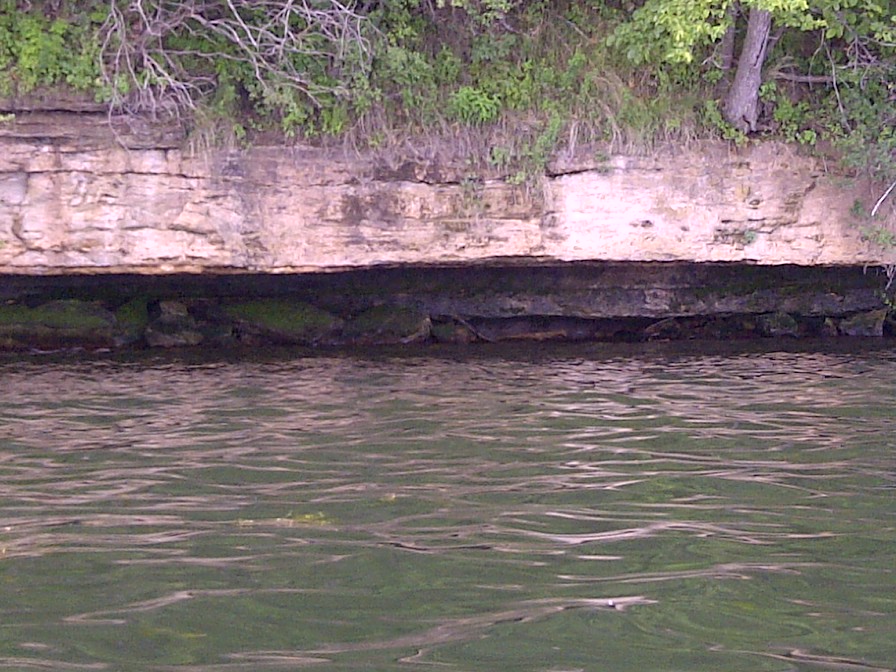 The Green Lake chapter has been working on the “Fish Sticks” project for Green Lake since last winter, beginning with a snowmobile ride around the lake shore GPS marking over 100 potential sites. Next step was to identify those GPS locations to the property owners, and begin contacting those owners.
The Green Lake chapter has been working on the “Fish Sticks” project for Green Lake since last winter, beginning with a snowmobile ride around the lake shore GPS marking over 100 potential sites. Next step was to identify those GPS locations to the property owners, and begin contacting those owners.
